

Remembering Jim Crow : presented by American RadioWorks. Bitter Times | Danger, Violence, Exploitation | "Behind the Veil" | Keeping the Past | Resistance | Whites Remember Jim Crow | Bitter Times.
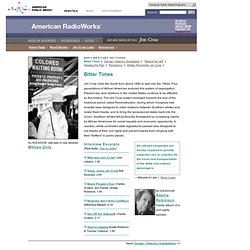
Remembering Jim Crow : Presented by American RadioWorks. Jim Crow laws robbed African Americans of basic rights.
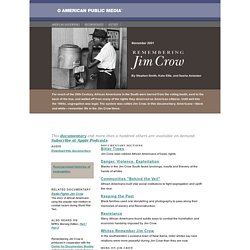
Danger, Violence, Exploitation Blacks in the Jim Crow South faced lynchings, insults and thievery at the hands of whites. Communities "Behind the Veil"African Americans built vital social institutions to fight segregation and uplift the race. Keeping the PastBlack families used oral storytelling and photography to pass along their memories of slavery and Reconstruction. ResistanceMany African Americans found subtle ways to combat the humiliation and economic hardship imposed by Jim Crow. Remembering Jim Crow : presented by American RadioWorks.
Bitter Times | Danger, Violence, Exploitation | "Behind the Veil" | Keeping the Past | Resistance | Whites Remember Jim Crow | Danger, Violence, Exploitation Life in the Jim Crow South was often dangerous for African Americans.
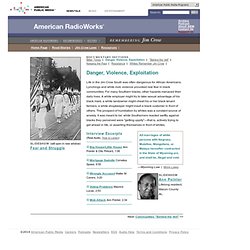
Lynchings and white mob violence provoked real fear in black communities. For many Southern blacks, other hazards menaced their daily lives. A white employer might try to take sexual advantage of his black maid, a white landowner might cheat his or her black tenant farmers, a white shopkeeper might insult a black customer in front of others. Remembering Jim Crow : presented by American RadioWorks. Bitter Times | Danger, Violence, Exploitation | "Behind the Veil" | Keeping the Past | Resistance | Whites Remember Jim Crow | Whites Remember Jim Crow Memories of Jim Crow naturally depend on who's doing the remembering.
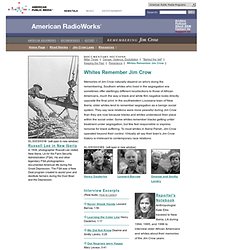
Southern whites who lived in the segregation era sometimes offer startlingly different recollections to those of African Americans, much the way a black and white film negative looks directly opposite the final print. In the southwestern Louisiana town of New Iberia, older whites tend to remember segregation as a benign social system. They say race relations were more peaceful during Jim Crow than they are now because blacks and whites understood their place within the social order. Remembering Jim Crow : presented by American RadioWorks. Bitter Times | Danger, Violence, Exploitation | "Behind the Veil" | Keeping the Past | Resistance | Whites Remember Jim Crow | Resistance A young historian once asked an elderly African American man when he had joined the civil rights movement, assuming that significant opposition to Jim Crow racism only emerged in the 1960s.
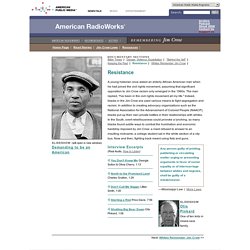
The man replied, "I've been in the civil rights movement all my life. " Indeed, blacks in the Jim Crow era used various means to fight segregation and racism. In addition to creating advocacy organizations such as the National Association for the Advancement of Colored People (NAACP), blacks put up their own private battles in their relationships with whites. Remembering Jim Crow : Presented by American RadioWorks.
Jim Crow Laws Starting in the 1890s, states throughout the South passed laws designed to prevent Black citizens from improving their status or achieving equality.

These statutes, which together were known as Jim Crow, were in place and enforced until the 1950s and 60s. Here is a sampling of those laws, grouped by topic. Florida: The schools for white children and the schools for negro children shall be conducted separately. Kentucky: The children of white and colored races committed to reform schools shall be kept entirely separate from each other. Mississippi: Separate schools shall be maintained for the children of the white and colored races. Mississippi: Separate free schools shall be established for the education of children of African descent; and it shall be unlawful for any colored child to attend any white school, or any white child to attend a colored school. Arizona: The marriage of a person of Caucasian blood with a Negro shall be null and void.
Remembering Jim Crow : presented by American RadioWorks. Bitter Times | Danger, Violence, Exploitation | "Behind the Veil" | Keeping the Past | Resistance | Whites Remember Jim Crow | Communities "Behind the Veil" The writer, scholar and activist, W.E.B.
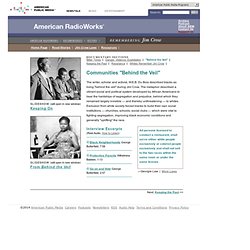
Du Bois described blacks as living "behind the veil" during Jim Crow. The metaphor described a vibrant social and political system developed by African Americans to bear the hardships of segregation and prejudice, behind which they remained largely invisible — and thereby unthreatening — to whites. Exclusion from white society forced blacks to build their own social institutions — churches, schools, social clubs — which were vital to fighting segregation, improving black economic conditions and generally "uplifting" the race.
Assignment 1: TKAM: Jim Crow Era. Who Was Jim Crow? The name Jim Crow is often used to describe the segregation laws, rules, and customs which arose after Reconstruction ended in 1877 and continued until the mid-1960s.
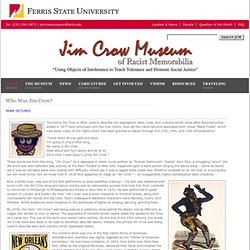
How did the name become associated with these "Black Codes" which took away many of the rights which had been granted to blacks through the 13th, 14th, and 15th Amendments? These words are from the song, "Jim Crow," as it appeared in sheet music written by Thomas Dartmouth "Daddy" Rice. Rice, a struggling "actor" (he did short solo skits between play scenes) at the Park Theater in New York, happened upon a black person singing the above song -- some accounts say it was an old black slave who walked with difficulty, others say it was a ragged black stable boy. Whether modeled on an old man or a young boy we will never know, but we know that in 1828 Rice appeared on stage as "Jim Crow" -- an exaggerated, highly stereotypical black character. Black & White Minstrels1950 Blackface Performance: Vernon & Ryan Minstrel Show Rap. What Was Jim Crow?
Jim Crow was the name of the racial caste system which operated primarily, but not exclusively in southern and border states, between 1877 and the mid-1960s.
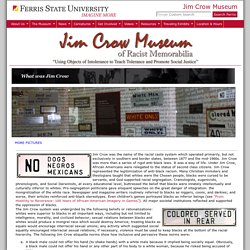
Jim Crow was more than a series of rigid anti-black laws. It was a way of life. Under Jim Crow, African Americans were relegated to the status of second class citizens. Jim Crow represented the legitimization of anti-black racism. Many Christian ministers and theologians taught that whites were the Chosen people, blacks were cursed to be servants, and God supported racial segregation. A black male could not offer his hand (to shake hands) with a white male because it implied being socially equal. Stetson Kennedy, the author of Jim Crow Guide (1990), offered these simple rules that blacks were supposed to observe in conversing with whites: Never assert or even intimate that a white person is lying.
Welcome to the Civil Rights Digital Library. The Office of War Information. Most images are digitized | All jpegs/tiffs display outside Library of Congress | View All The photographs in the Farm Security Administration/Office of War Information Photograph Collection form an extensive pictorial record of American life between 1935 and 1944.

This U.S. government photography project was headed for most of its existence by Roy E. Stryker, who guided the effort in a succession of government agencies: the Resettlement Administration (1935-1937), the Farm Security Administration (1937-1942), and the Office of War Information (1942-1944). The collection also includes photographs acquired from other governmental and non-governmental sources, including the News Bureau at the Offices of Emergency Management (OEM), various branches of the military, and industrial corporations. For a video overview of the collection, see "Documenting America, 1935-1943: The Farm Security Administration/Office of War Information Photo Collection.
" Research Tips.